Qualcomm Snapdragon 805 Performance Preview
by Anand Lal Shimpi on May 21, 2014 8:00 PM EST- Posted in
- Tablets
- Snapdragon
- Qualcomm
- Mobile
- SoCs
- Snapdragon 805
CPU Performance
As always we'll start out our performance investigation with a handful of CPU bound web browser based tests. In all cases we used Chrome on the MDP/T. Remember there's only an 8% increase in peak CPU frequency here, so I wouldn't expect a huge difference vs. Snapdragon 801.
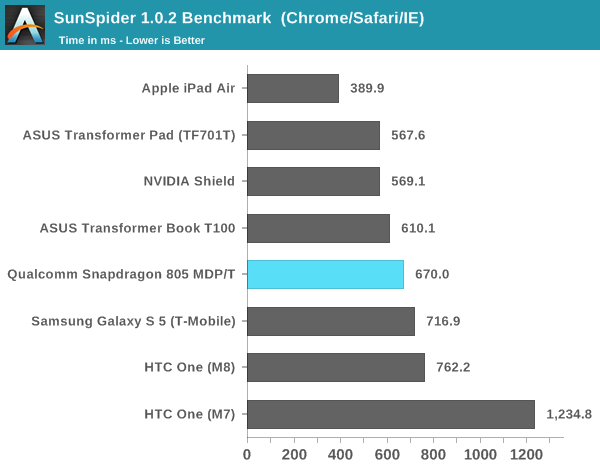
Here the MDP/T scales pretty well, showing a 6% improvement in performance over the Snapdragon 801 based Galaxy S 5. In the case of the GS5 we are looking at a 2.5GHz Snapdragon 801 implementation, so the improvement makes sense. Both the Cortex A15 (TF701T/Shield) and Apple's Cyclone (in the iPad Air) are higher performing designs here. Since there's no fundamental change to Krait's IPC, the only gains we see here are from the higher clock speed.
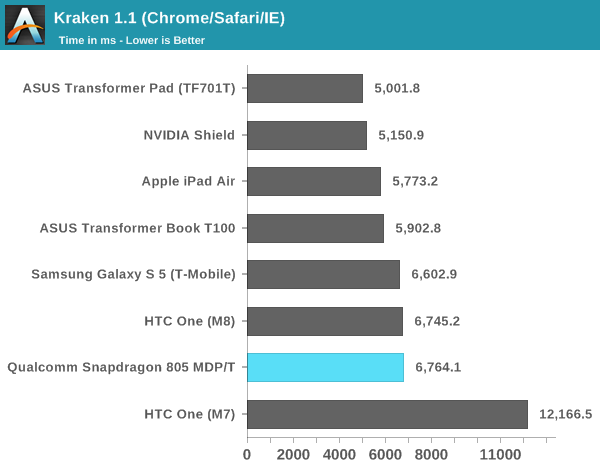
Kraken appears to be at its limit when it comes to Krait 400/450, there's effectively no additional frequency scaling beyond 2.3GHz. We're either running into an architectural limitation or limits of the software/browser combination itself.
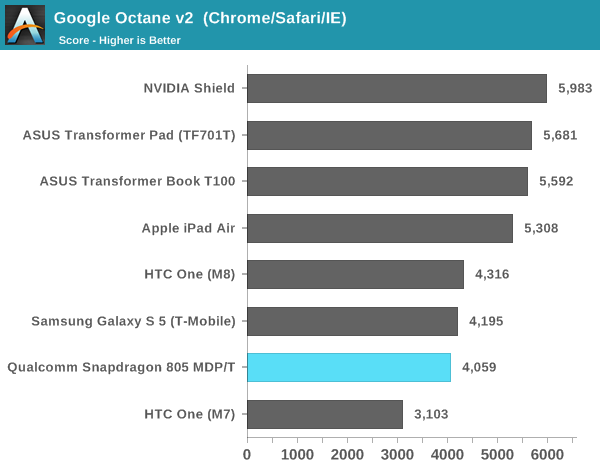
Similarly we don't see any real progress in the Google Octane test either. Snapdragon 805's CPU cores may run at a higher peak frequency but that's definitely not the story here.
Basemark OS II
Basemark OS II gives us a look at native application performance across a variety of metrics. There are tests that hit the CPU, GPU as well as storage subsystems here. The gains here are exclusively on the graphics side, which makes sense given what we've just seen. Snapdragon 805's biggest gains will be GPU facing.
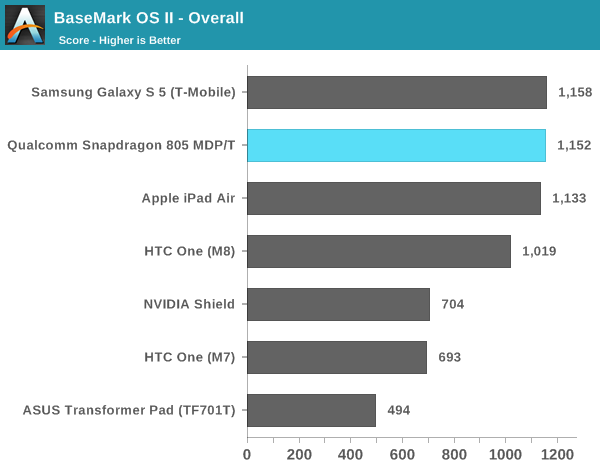
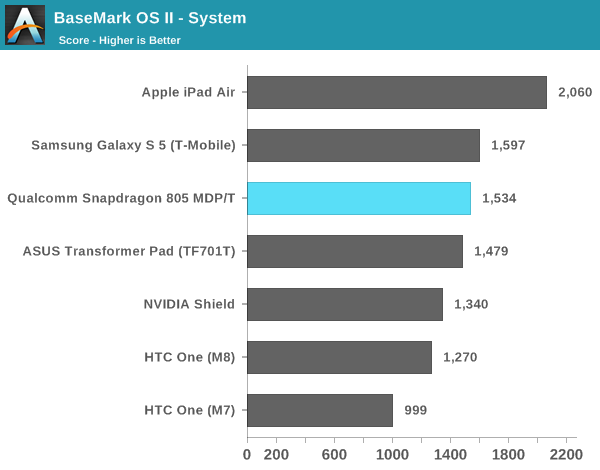


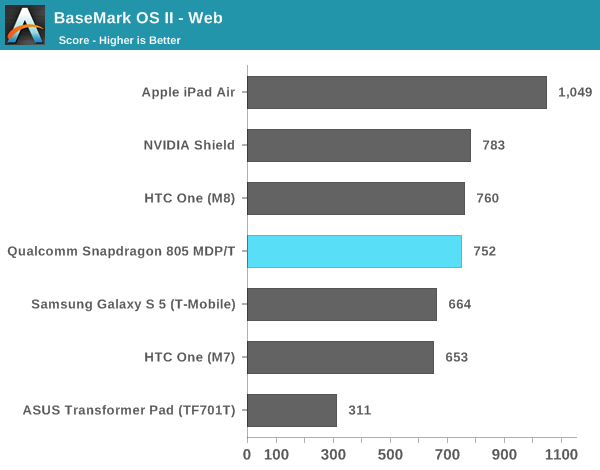
Geekbench 3.0
Although I don't typically use Geekbench, I wanted to include some numbers here to highlight that the increase in memory bandwidth for S805 over S801 doesn't really benefit the CPU cores:
| Geekbench 3.0 | |||||
| Snapdragon 801 2.3GHz (HTC M8) | Snapdragon 805 2.7GHz (MDP/T) | % Increase for S805 | |||
| Overall (Single thread) | 1001 | 1049 | 4.8% | ||
| Overall (Multi-threaded) | 2622 | 2878 | 9.7% | ||
| Integer (Single thread) | 956 | 996 | 4.2% | ||
| Integer (Multi-threaded) | 2999 | 3037 | 1.3% | ||
| FP (Single thread) | 843 | 925 | 9.7% | ||
| FP (Multi-threaded) | 2636 | 3155 | 19.7% | ||
| Memory (Single thread) | 1411 | 1406 | 0% | ||
| Memory (Multi-threaded) | 1841 | 1949 | 6% | ||
I wouldn't read too much into the multithreaded FP results, I suspect we're mostly seeing differences in thermal dissipation of the two test units. A closer look at the memory bandwidth numbers confirms that while the 805 has more memory bandwidth, most of it is reserved for GPU use:
| Geekbench 3.0 - Memory Bandwidth | |||||
| Snapdragon 801 2.3GHz (HTC M8) | Snapdragon 805 2.7GHz (MDP/T) | % Increase for S805 | |||
| Stream Copy (Single thread) | 7.89 GB/s | 8.04 GB/s | 1.9% | ||
| Stream Copy (Multi-threaded) | 9.53 GB/s | 10.1 GB/s | 5.9% | ||
| Stream Scale (Single thread) | 5.36 GB/s | 5.06 GB/s | - | ||
| Stream Scale (Multi-threaded) | 7.31 GB/s | 7.63 GB/s | 4.3% | ||
| Stream Add (Single thread) | 5.27 GB/s | 5.2 GB/s | - | ||
| Stream Add (Multi-threaded) | 6.84 GB/s | 7.51 GB/s | 9.8% | ||
| Stream Triad (Single thread) | 5.64 GB/s | 5.85 GB/s | 3.7% | ||
| Stream Triad (Multi-threaded) | 7.65 GB/s | 7.89 GB/s | 3.1% | ||










149 Comments
View All Comments
grahaman27 - Wednesday, May 21, 2014 - link
will apple?Thermogenic - Thursday, May 22, 2014 - link
It remains to be seen how good yields are for 20mm at TMSC. My guess id "not very" since Maxwell launched at 28mm.Kevin G - Thursday, May 22, 2014 - link
The low end Maxwell parts also launched a bit earlier than expected. TSMC 20 nm wouldn't have been ready regardless of yields.The real question is if the bigger Maxwell chips will use 20 nm and when they're ready to ship.
kwrzesien - Thursday, May 22, 2014 - link
I'd really like to seem them go ahead and release the medium Maxwell on 28mm for a GTX760ti.testbug00 - Thursday, May 22, 2014 - link
3 28nm dies (GM107, GM204 and GM206). One 20nm die GM200 (210?)GM204/206 will be october at earliest, more likely later... Hopefully not 2015, but, it could end up 2015 :(
testbug00 - Thursday, May 22, 2014 - link
Maxwell was planned to (mostly) be on 28nm years back.Only Maxwell silicon not on 28nm is the one that would be to large (likely, 10-12 billion transistor chip)
name99 - Thursday, May 22, 2014 - link
OR Apple was willing to pay more than nV to secure access to the limited 20nm capacity...retrospooty - Thursday, May 22, 2014 - link
I am guessing not... These foundries all use same stuff. If 20nm isnt ready it isnt ready. There is pretty much TSMC, UMC (formerly AMD) and Samsung, and Intel that are capable of producing at Volume. Intel is obviously not part of this equation. I am not aware of any of the other 3 that are making 20nm chips at volume in 2014. They usually all 3 go in step at the same time. I am 99% sure the Apple A8 or whatever is in the next iPhone iPad will stil be 28nm.GC2:CS - Thursday, May 22, 2014 - link
But how they will make that compulsory 2 x jump then ? Not say its impossible on 28 nm but 20nm would help a lot. Also if 28 nm it will be samsung or TSMC ? Because TSMC has more matured 28 nm process than samsung even that could be possibly enough to make that 2x jump. And hell Apple got billions to spend... Why is 20 nm so much behind the shelude ? Isn't that just Apple with an secret exclusive multibillion deal sucking off the entire TSMC ?tuxfool - Friday, May 23, 2014 - link
Small Correction. UMC isn't former AMD. GF (Global Foundries) is former AMD